William Frederick Morgan enlisted in the Great War with the Royal Engineers in England on 22 June 1915. Wounded in France in March 1918, Morgan survived the war and was honourably discharged on 19 February 1919. In 1920 he emigrated to Australia with his wife Florence and their infant daughter Joyce and they settled in New South Wales. Their son William was born in Newtown on 11 December 1924.
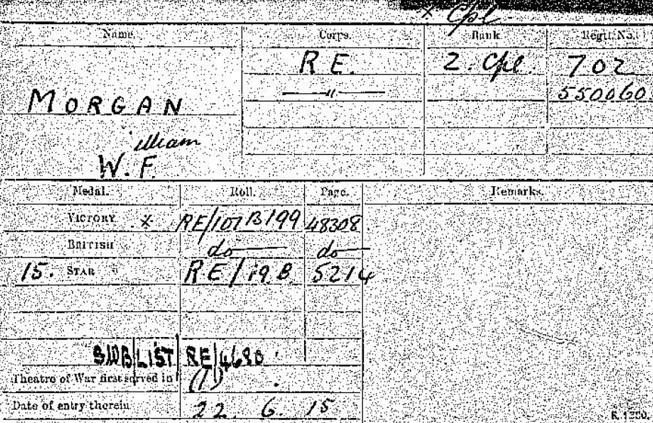
Image: W.F. Morgan, Medal Card, National Archives UK, WO372/14/90410.
Like so many sons of Great War veterans, William Morgan was keen to serve his country during the next war and on 10 February 1943, the eighteen-year-old process worker attested at Paddington, NSW, for the Citizen Military Forces as a Gunner with the 2 Australian Anti-Aircraft Training Regiment. However, he seems to have changed his mind about his wartime career choice and he was discharged on 28 March 1943. On the following day Morgan enlisted in Sydney with the Royal Australian Navy (RAN) for three years duration. He spent the next six months training on HMAS Cerberus and from September 1943 until August 1945 Morgan served on HMAS Arunta rising in rank to Able Seaman.
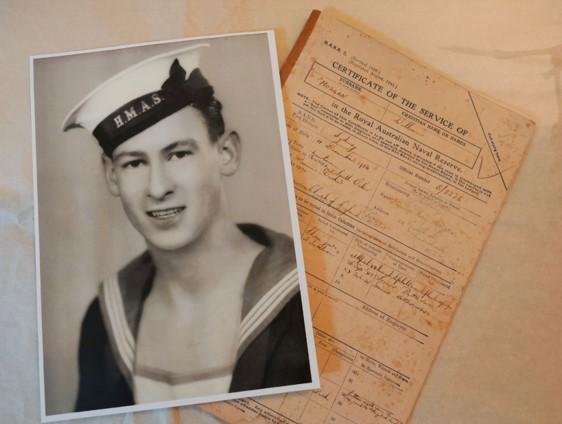
Image: Able Seaman William Morgan RAN, Anzac Memorial Collection.
HMAS Arunta and Cockatoo Island
The Arunta name came from the Arunta Aboriginal people (also spelt Arrernte or Aranda) in central Australia and the ship’s motto was ‘Conquer or Die’.[1] She was laid down at Cockatoo Docks in Sydney Harbour on 15 November 1939 and was the first of three Tribal-class destroyers built at Cockatoo Dockyard during the Second World War.
In 1941, when Japan entered the war, the Pacific became the stage for much naval activity and after the fall of Singapore in February 1942, Cockatoo Island was the only dockyard in the South-West Pacific where major repairs could be carried out. At the height of the war, 400 people were employed on the island. Australian, American and British ships regularly sailed to Cockatoo Island for conversion and repairs, and some arrived heavily damaged.
By the end of the war, 250 ships had been repaired on the island and 750 ships had docked there.
The launch
The Arunta was officially launched on 30 November 1940. For the shipbuilders and workers on Cockatoo Island, the day was a very memorable one.
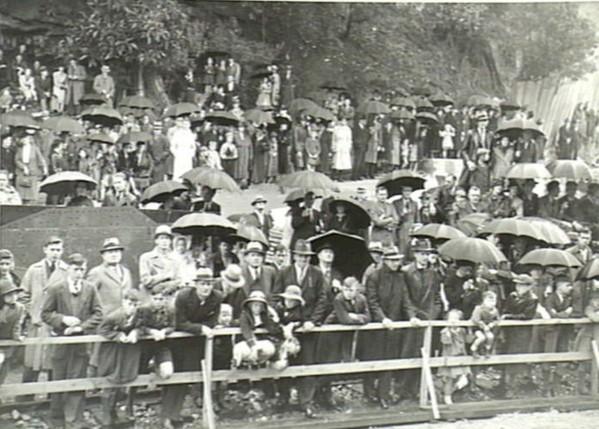
Photo: Some of the workmen who built the Arunta with their wives and children at the launch, AWM 003863.
At nearly 2000 tons, she was the largest naval vessel to be launched in the Commonwealth since the seaplane carrier HMAS Albatross slid down the ways at Cockatoo Island in 1928. She was also the fastest ship that had been built for the RAN at the time.
Unfortunately, driving rain and a howling gale drowned out the ceremony and the large crowds of island workers who had excitedly gathered there with their wives and children huddled beneath their hats and their caps and a canopy of drenched umbrellas. As did the choir girls and boys from St John’s Church, Balmain who were there to sing for the very momentous occasion. Few in the crowd heard Lady Zara Gowrie, protected from the elements by an awning over the launching platform, say as she named the ship, ‘may it be her destiny that she adds one more page to the glorious history of the Royal Australian Navy.’ Lady Gowrie then cut the ribbon which sent a bottle of champagne smashing against the stern of the ship and launched her on her way.[2]
Yet the deluge was so thick that the flood that poured from the sides of the destroyer affected the tallow on the slips and the Arunta stopped before she was completely waterborne. Tugs were subsequently deployed to take her fully into the squally waters of the harbour.
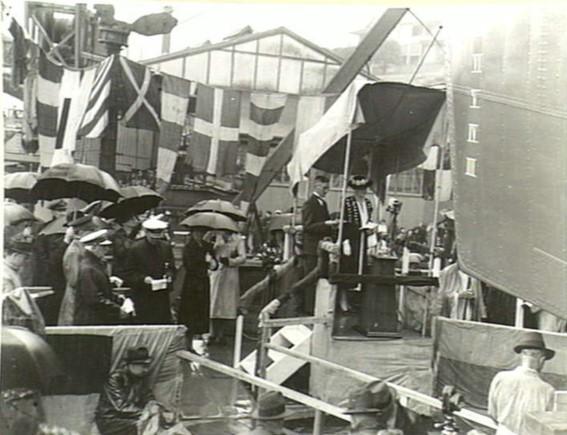
Photo: Lady Gowrie christens HMAS Arunta, AWM 003861.
In a speech after the launch, the Governor-General Lord Gowrie, himself a highly decorated war veteran remarked that the occasion was a very important one for the nation. The day witnessed the launch of a warship built in an Australian dockyard from Australian material by Australian workmen which was to be commanded and manned by Australian officers and crew.[3] He further noted that the workmanship was of the highest order and he praised the loyal co-operation of all who were employed in the shipbuilding industry because ‘every bolt and every rivet that is hammered into the hull of one of these ships is a nail in the coffin of Hitler and his gang’.[4] And whilst the Arunta did not deploy to Europe during the war, nonetheless, she played an extremely significant role in the war in the Pacific.
Wartime service in the Pacific
HMAS Arunta was commissioned on 30 March 1942 under the command of the highly experienced and well-regarded Commander James Cairns Morrow DSO RAN, with a complement of twelve officers and 178 crew.[5] She was immediately placed on anti-submarine patrol off the Australian east coast and was in Sydney waters at the time of the audacious Japanese midget submarine attacks in May and June 1942.
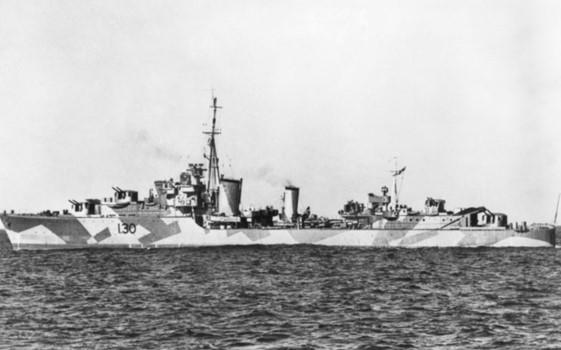
Photo: Tribal-class destroyer HMAS Arunta, AWM 093285.
On 29 August 1942, whilst escorting convoys and other shipping between Australia and New Guinea, she experienced her first contact with the enemy when she single-handedly sank the Japanese submarine R033 with depth chargers, ten nautical miles off Port Moresby. Three weeks previously, on 7 August, the fearsome R033 had shelled and sunk the Burns Philp ship Mamutu in the Gulf of Papua near Murray Island. The Australian merchant ship was evacuating civilians from Port Moresby to Daru ahead of advancing Japanese forces in New Guinea. As the desperate, disabled Mamutu began to sink, the R033 ‘cruised among the survivors in the water – men, women and children – and machine-gunned them. Survivors were later seen, boat less in the water, and rafts were dropped by Allied aircraft’.[6] Tragically, of the crew of thirty-nine and 103 passengers, 114 lives were lost. The destruction of this much feared enemy submarine with all seventy men aboard was thus a major boon to Allied shipping in the area and indeed a battle honour for the Arunta and her crew. Commander Morrow was subsequently awarded the Distinguished Service Cross for the highly significant action.
In September 1942 the Arunta was again escorting convoys to New Guinea and while thus engaged took on board the survivors of the SS Anshun at Milne Bay after that ship had been sunk by Japanese cruisers on the night of 6-7 September.[7] In October she landed the 2/12th Battalion on Goodenough Island and successfully evacuated Lancer Force from enemy-infested Timor to bomb-battered Darwin on 10 January 1943.
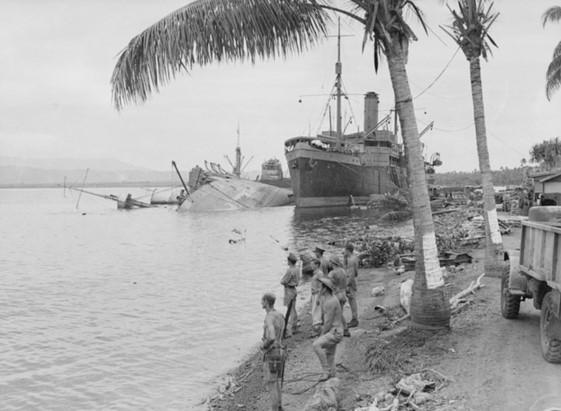
Photo: Anshun lying on her side in Milne Bay, September 1942, AWM 026666.
By the time S/8278 William Morgan began to serve aboard the Arunta in September 1943, the vessel was part of the legendary Task Force 74, the composite Australian-American force operating in the South Pacific. Task Force 74 included the cruisers HMAS Australia and HMAS Shropshire, the sister Tribal-class destroyer Warramunga and the three LSI (Landing Ship Infantry) HMAS Westralia, Manoora and Kanimbla. In October 1944, she played a vital supporting role in amphibious operations during the largest naval battle of the war at Leyte Island in the central Philippines. Here, she took part in the frenzied pre-landing bombardments and on 24-25 October at the Battle of Surigao Strait, the Arunta led the US destroyers USS Killen and USS Beale in a successful torpedo attack against the Imperial Japanese Navy which was all but annihilated during the night-time engagement. According to the Arunta’s official action report, by the morning of 25 October:
‘many [Japanese] survivors were seen in the water and each destroyer was given permission to pick up not more than 75 and to search them thoroughly and to take no misbehaviour from them. However, they refused to be taken on board – probably with the hope that some Jap barges will come off from either side of the straits later and pick them up, or possibly with their usual suicidal masochism…’[8]
The Arunta remained with the task groups patrolling the Leyte area until 16 November when she sailed for Manus.
Later, in January 1945, the Arunta again played a central supporting role in the second phase of the Philippines campaign during the invasion of the Lingayen Gulf. Here, the massive Allied armada including eleven RAN ships came under repeated attack from Japanese aircraft and surface ships and on 5 January the Arunta was damaged when a kamikaze pilot narrowly missed crashing into her port side. A bomb carried by the plane however, blew several holes in the ship’s hull. Six crew members were seriously injured and two ratings sadly died of their wounds, yet remarkably they were to be the ship’s only fatalities during the war.[9] Other RAN ships were much less fortunate and between 5 and 9 January, the flagship HMAS Australia (II) was hit by five Japanese kamikaze suicide dive bombers who saw in self-immolation their country’s salvation. Three officers and forty-one ratings were killed and many more were wounded. This was to be Australia’s last action during the war.[10] Until the close of February Arunta continued to support the Philippines campaign as a unit of Lingayen Defence Force and in March both the Arunta and Shropshire left the Squadron for Sydney for overdue rest and refit.[11]
Sailing again on 2 May 1945, the Arunta participated in the 6th Australian Division landing at Wewak, New Guinea and June found her in Brunei Bay on the north-west coast of Borneo, providing cover for the Australian landings here. On 27 June she took part in the pre-landing bombardment of the oil port of Balikpapan on the south-east coast, expending a total of 601 rounds of 4.7-inch ammunition.[12]
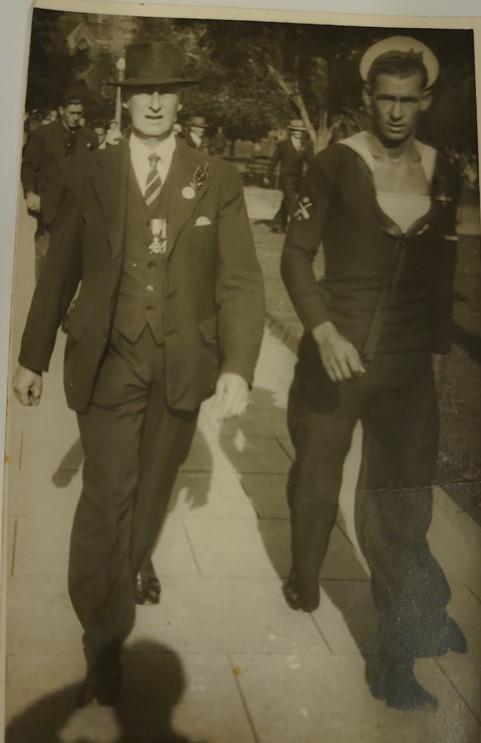
Photo: William F. Morgan and William Morgan, Hyde Park, Anzac Day 1946, Anzac Memorial Collection.
When VJ Day came on 15 August 1945, the Arunta was docked at the place of her launch and was refitting at Cockatoo Dock having steamed 184,368 miles on military service in the South-West Pacific. The date was a highly significant one for Able Seaman William Morgan too because he left the Arunta that very same day and transferred back to HMAS Cerberus. He was later attached to HMAS Penguin, Barwon and Rushcutter until he was discharged from the RAN on 30 April 1946.
Just five days before, William Morgan had marched with his Great War veteran father in the Anzac Day parade in Sydney. It was the first Anzac Day since hostilities had ended, and it was probably a very celebratory and memorable day for them both.
Indeed, William Morgan was clearly proud of his service aboard HMAS Arunta. During his time on the ship he drew an accurate outline of her and carved a rather expertly hand-crafted sea-line wooden model whilst at sea. The unique model is 335 mm long by seventy mm high and was donated to the Anzac Memorial in 2022 by his son Tony. Other related ephemera from Morgan’s RAN service were also donated including pennants from the Arunta and HMAS Barwon and an attractive framed print of a post-war painting of the ship escorting Australian troop ships in 1944.
The Morgan family also generously donated both father and son’s service medals – a very fitting testament to their brave and committed military service during two world wars.
'
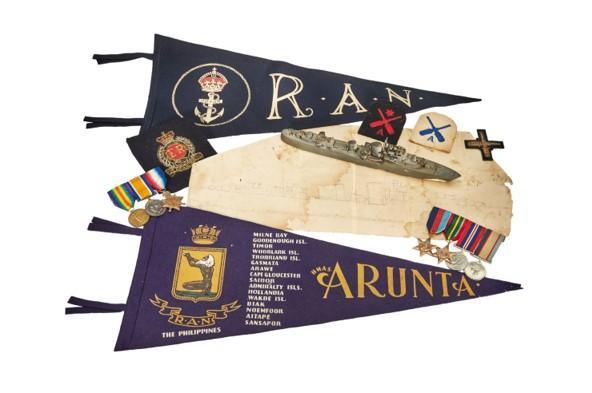
Image: Morgan Collection, Anzac Memorial Collection.
Post war duties
For the Arunta, the end of the war in the Pacific did not mean the end of her military duties however, and in October 1945 she sailed to Darwin and escorted the repatriation ship Esperance Bay to Timor and thence to Java. In November she proceeded to Japan via Morotai and onto Guam to join the naval forces attached to the British Commonwealth Occupation Force (BCOF). The Arunta remained in Japanese waters as the Australian Squadron representative until March 1946. She returned to Sydney on 2 April 1946 in need of repair which once again sent her back to Cockatoo Island.
HMAS Arunta was active for some years after the war and in 1955 became one of the first RAN ships to join the Commonwealth Strategic Reserve, setting the pattern for RAN South-East Asian deployments. The China Steel Corporation of Taipei in Taiwan bought Arunta for scrap in 1968. She departed on her final voyage from Garden Island in Sydney for the breakers yard on 12 February 1969 under tow by the Japanese tug Toko Maru. It was alas to be a fateful journey. According to the Naval Historical Society of Australia:
‘the old warhorse was reluctant to leave her homeland and on the following day, in good weather when off Broken Bay, she inexplicably began to list to starboard; as the list increased the tug master turned around and attempted to take his charge back to Sydney. But the list increased and as Arunta lay over on her side the tow was slipped and in deep water she disappeared below the waves.’[13]
The mystery of her sinking sixty-five miles off the NSW coast from Sydney has never been fully explained and although her loss was officially investigated by the maritime authorities, the results were inconclusive. There were rumours swirling at the time that some disgruntled ex-Arunta crew had sabotaged the ship prior to her departure from Sydney. For them, and if true, a mournful and yet monumental wreck in local waters was perhaps preferable to her being dissected and repurposed overseas.
But whatever occurred in those final hours, it was a rather sad and ignoble end for Australia’s first Tribal-class destroyer whose distinguished career during the war in the Pacific and beyond it, marks her as one of the most important ships to have ever served in the RAN. Yet despite her untimely sinking, on quiet reflection, ‘Conquer or Die’ was a very fitting motto for HMAS Arunta indeed.
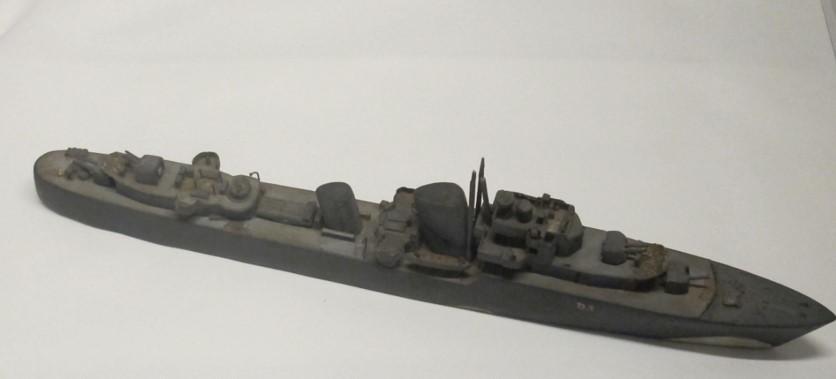
Image: Model of HMAS Arunta made by William Morgan, Anzac Memorial Collection.
Notes
- The Arrernte region is large and diverse and covers an area from Tea Tree to the north of Alice Springs, west to the WA border, east to the Queensland border and south to Uluru.
- ‘Arunta Destroyer is Launched in Rain’, Truth, Sunday 1 December 1940, p 20.
- For his long and distinguished military and political career see https://adb.anu.edu.au/biography/gowrie-first-earl-of-6441
- ‘Launching of New Destroyer’, The Sun, Saturday 30 November 1940, p 3.
- J. C. Morrow, from Melbourne, Victoria, joined the RAN on 1 January 1919 as a 14-year-old cadet and rose to the rank of Commodore before retiring from the Navy on 6 February 1960. For his long and illustrious naval career see https://adb.anu.edu.au/biography/morrow-james-cairns-11179
- G. Hermon Gill, Australia in the War of 1939-1945, Series 2, Navy, Volume 2, Royal Australian Navy 1942-1945, AWM, Canberra, 1968, p 160.
- G. Hermon Gill, Australia in the War of 1939-1945, Series 2, Navy, Volume 2, Royal Australian Navy 1942-1945, AWM, Canberra, 1968, pp 171-72.
- Action Report for the night of 24/25 October 1944, Anzac Memorial Collection.
- They were 6092 Able Seaman Henry Louis Sellick aged 42 years and 24357 Stoker Petty Officer Richard Allen Hand aged 26 years. Both were buried at sea and are today commemorated at the Plymouth Naval Memorial in England alongside 23,220 other British and Commonwealth seamen who were lost at sea during both world wars.
- See https://www.navy.gov.au/hmas-australia-ii
- A. K. Macdougall, Australians at War, A Pictorial History, The Five Mile Press, Victoria, revised edition 2004, p 302.
- The taking of Balikpapan witnessed the largest (and last) Australian amphibious landing of the Second World War and it was accompanied by intense naval gunfire and massive aerial bombardment. See Brad Manera, In That Rich Earth, Trustees of the Anzac Memorial Building, Hyde Park, Sydney, 2019, p 181 and Chris Coulthard-Clark, The Encyclopedia of Australia’s Battles, Allen & Unwin, Crows Nest, NSW, 2001 edition, pp 254-55.
- See https://navyhistory.org.au/hmas-arunta-and-operation-hamburger/
- See https://navalinstitute.com.au/12-feb-1969-arunta-goes-down/
